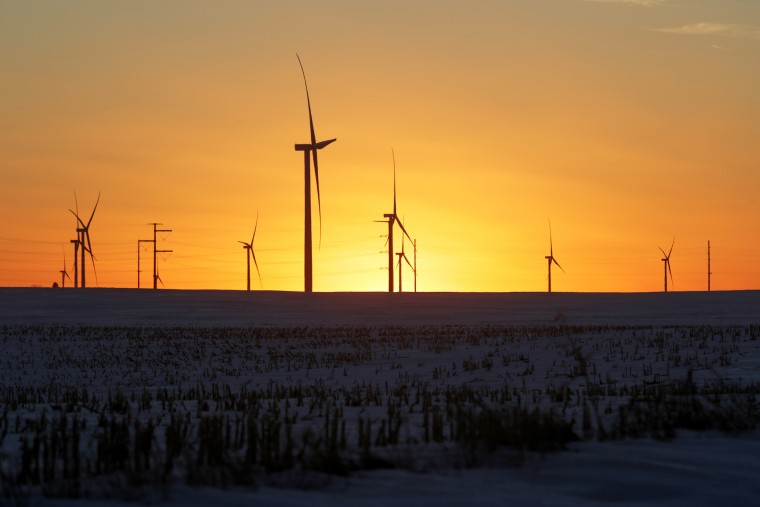Joe Biden plans to build huge offshore wind farms to tackle the climate crisis

President Joe Biden's administration has detailed a plan to build huge offshore wind farms in the United States.
The White House said the plans would create up to 44,000 jobs by 2030.
President Biden has called climate change one of the four "major crises" he plans to tackle as president.
President Joe Biden's administration has detailed a plan to build huge offshore wind farms in the United States as part of his plans to tackle climate change.
The project, which was unveiled on Monday, aims to create 30 extra gigawatts of offshore wind generation to US coastlines by 2030, while creating tens of thousands of jobs.
The White House said meeting that target would cost $12 billion a year in capital investment on both US coastlines and would employ 44,000 workers, as well as 33,000 additional jobs in communities supported by offshore wind generation.
The wind farms would supply power to 10 million homes and cut carbon dioxide emissions by 78 million metric tons, the White House said.
As one part of the efforts, Interior Department announced a new "priority wind energy area" in the New York Bight, a shallow area between Long Island and the New Jersey coastline, where the agency hopes to construct a wind farm by 2030.
"The announcements we're making today I hope will just jump-start everyone's understanding of the potential for offshore wind energy, and move this industry forward in a way that's going to allow us to really focus on the supply chain issue as well, because we're not just talking about erecting wind turbines in the oceans, we're talking about massive turbines that are actually manufactured in the United States," national climate adviser Gina McCarthy said Monday, in comments reported by Politico.
President Biden pledged to make tackling climate change a central part of his agenda in the White House, describing it as one of the four "major crises" facing the United States.
In his first week in office, he issued an executive order calling on the United States to create a "clean energy economy" and create millions of new jobs.
Biden administration plans major reboot for U.S. offshore wind power
The federal government will create a New Wind Energy Area offshore between Long Island and the New Jersey coast.

A wind farm shares space with corn fields in Latimer, Iowa, on Feb. 2, 2020.
Jonathan Ernst / Reuters file
March 29, 2021,
March 29, 2021,
By Josh Lederman
WASHINGTON — The offshore wind industry is getting a major boost from the Biden administration as the White House aims to reinvigorate a potential source of renewable, emissions-free electricity that has never fully taken off in the United States.
As part of a government-wide effort announced Monday, the White House set a new target to deploy enough offshore windmills to power millions of American homes — 30 gigawatts — by 2030.
To accomplish that goal, the Interior Department will create a New Wind Energy Area offshore between Long Island and the New Jersey coast, where the administration will lease space, Interior Secretary Deb Haaland said.
The Interior Department also announced it would move ahead with a key environmental review needed to proceed with permitting for Ocean Wind, a major project planned off the coast of New Jersey, which would be the third commercial offshore wind project for the U.S.
MARCH 9, 2021 01:41
The White House said hitting their new target would directly employ more than 44,000 people, with tens of thousands more jobs created by increased economic activity in nearby communities.
Energy Secretary Jennifer Granholm said the approach to offshore wind in the past has “looked like a chicken with its head cut off.”
“It is a new day under the Biden administration,” Granholm said.
Offshore wind — in which gigantic wind turbines located in waters off the coast churn out electricity to power homes and businesses onshore — is an untapped opportunity to expand electrical generation from sources that don’t produce heat-trapping greenhouse gases blamed for global warming.
But in the U.S., while on-land wind farms have flourished in recent years, offshore wind has yet to take off in a significant way, in part due to bureaucratic and permitting hurdles that were a source of major frustration for renewable energy companies during the Trump administration. As of now, the U.S. has only one operational offshore commercial wind farm, with just five turbines.
In contrast, wind energy from onshore wind farms made up more than 8 percent of U.S. electricity generation in 2020, according to U.S. Energy Information Administration data, a number that is expected to grow.
The White House said hitting their new target would directly employ more than 44,000 people, with tens of thousands more jobs created by increased economic activity in nearby communities.
Energy Secretary Jennifer Granholm said the approach to offshore wind in the past has “looked like a chicken with its head cut off.”
“It is a new day under the Biden administration,” Granholm said.
Offshore wind — in which gigantic wind turbines located in waters off the coast churn out electricity to power homes and businesses onshore — is an untapped opportunity to expand electrical generation from sources that don’t produce heat-trapping greenhouse gases blamed for global warming.
But in the U.S., while on-land wind farms have flourished in recent years, offshore wind has yet to take off in a significant way, in part due to bureaucratic and permitting hurdles that were a source of major frustration for renewable energy companies during the Trump administration. As of now, the U.S. has only one operational offshore commercial wind farm, with just five turbines.
In contrast, wind energy from onshore wind farms made up more than 8 percent of U.S. electricity generation in 2020, according to U.S. Energy Information Administration data, a number that is expected to grow.
Biden administration designates new offshore wind energy area

Wind Energy Areas(WEAs)
NEW YORK
Long Island
NEW
JERSEY
Barnegat Light
New York/New Jersey Bight
10 miles
Another reason offshore wind has been slow: The Energy Department has said that more than 58 percent of offshore wind resources are in “deep water,” where it’s impractical to attach massive structures to the seabed and floating platforms must be used instead, a nascent technology that until recently has often been cost-prohibitive.
To accelerate offshore wind growth, the Energy Department plans to make $3 billion in funding available through its loan guarantee program, which will also target equipment suppliers and development of transmission for power generated from offshore wind.
“President Biden believes we have an enormous opportunity in front of us to not only address the threats of climate change, but use it as a chance to create millions of good-paying, union jobs that will fuel America’s economic recovery,” Gina McCarthy, the White House national climate advisor, said in a statement.
Moving the U.S. toward renewable, low-carbon energy sources like wind, solar and geothermal is critical to Biden’s goals of zeroing out greenhouse gas emissions from the power sector by 2035 and from the entire U.S. economy by 2050.
Yet to meet global goals to keep climate change in check, the U.S. must also “electrify” other sectors that currently are powered by burning fossil fuels, such as cars and trucks, heating for homes and businesses, and gas cooking stoves. That means the U.S. must plan to use far more electricity in the coming years than it does now. To achieve the intended emission reductions, that electricity must come from renewable sources like wind rather than from coal- or gas-fired power plants, creating yet more pressure for the U.S. to quickly ramp up production of offshore wind power.
In one early action aimed to speed up the industry’s growth, shortly after Biden took office his administration renewed the permitting process for the stalled Vineyard Wind project off Martha’s Vineyard. The developer has said the project will create enough electricity to power 400,000 Massachusetts homes.
The White House’s push to ramp up offshore wind was quickly praised by environmental groups and climate hawks in Congress. House Natural Resources Committee Chairman Raul Grijalva, D-Ariz., said the U.S. would “benefit tremendously” from the Biden administration’s commitment to clean energy such as wind.
“The positive contrast with the Trump administration couldn’t be more obvious,” Grijalva said.

No comments:
Post a Comment